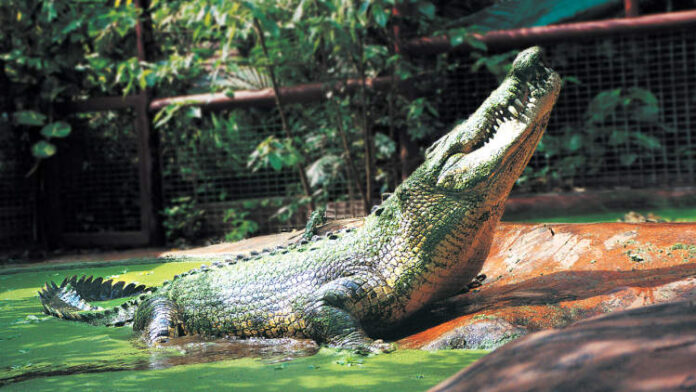- We sure hope someone calls up ‘happy and healthy’ by the time we’re 120.
Some animals — reptiles in particular — live for a surprisingly long time. Just as an example, Jonathan, the world’s oldest living tortoise, turned 190 last year.
But tortoises aren’t the only long-living scaly creatures out there. Ladies and gentlemen, meet Cassius.
Cassius is an Australian saltwater crocodile, living at the Marineland Melanesia Crocodile Habitat. He’s the world’s largest living crocodile in captivity, clocking in at just a smidgen under 18 feet in length.
He’s also one of the oldest. Earlier this month, Cassius reached the venerable age of 120.
Or at least that’s what we think.
It’s pretty difficult to actually know Cassius’ actual age. It’s not like he has a birth certificate, and you try getting close enough to perform tests on the gargantuan monster.
Although he definitely counts as a senior, Cassius isn’t a frail old man. He’s still got plenty of spunk left in him, and experts don’t see any reason why he wouldn’t live for many years more.
Let’s take a look at Cassius’ life and see who this enormous best actually is.
The Mystery of the Old Crocodile
As we mentioned, no one’s quite clear on when Cassius crawled out of his egg. According to estimates, he was born roughly around 1903.
That was the same year that Wilbur and Orville Wright performed the first flight on a powered aircraft. Needless to say, the world’s changed quite a bit over Cassius’ life.
Now, it is possible that he could be much younger. It’s very difficult to estimate a crocodile’s age because of their irregular growth patterns.
Crocodiles grow in very fast spurts when they’re young. As they age, their growth slows exponentially and eventually comes to a crawling stop.
That means a 70-year-old croc could be about the same size as an 80-year-old one. You can see why evaluating Cassius’s actual age is so challenging.
Yet, based on modern knowledge about crocodile aging, everything about Cassius indicates that his age is about right.
Old Cattle Rustler
Cassius first came to human attention in the early 1980s after ranchers around Darwin, Australia, noticed their livestock was going missing. After Cassius was spotted, it became pretty clear where the animals had ended up.
In his stomach, just so we’re clear.
Fortunately for Cassius, he didn’t receive the death sentence for his crimes. Instead, researchers captured the already-ginormous croc in 1984.
“He was a big old gnarly crocodile then … crocs of that size are not normal,” Crocodile Researcher Graeme Webb (who was in his 30s at the time of Cassius’ capture) told ABC.
At the time, Cassius was 16 feet and 10 inches long. As you can see, he’s grown a bit over the last 40 years, which is unusual for a beast of his caliber.
Cassius arrived at Marineland Melanesia in 1987. Since then, he has lived a peaceful life in the crocodile park.
Trauma from Yesteryear
Yet, before retiring to the park, Cassius’ life was far from easy. His scaly body is covered in dozens and dozens of gnarled scars, most of which experts believe he received fighting other crocodiles in his youth.
But not all of Cassius’ injuries came from his fellow reptiles. At the time of capture in 1984, the beast was missing the tips of both his snout and tail.
“He had the tip of his snout broken, which you can get from attacking a propeller,” Webb said.
This fact has led researchers to believe that Cassius may have attacked boats during his years in the wild.
“The scales on the front of [crocodiles’] mouth are all about pressure receptors—they’re all about honing in on prey,” Sally Isberg, managing director at the Center for Crocodile Research in Australia told LiveScience.
“Maybe those boat motors [created] extra vibration that quite irritated him. When a croc gets irritated by something, the only way he can express that irritation is to go to bite at it.”
A boat injury could also explain Cassius’ phobia of machines. If the staff at the crocodile park use loud machinery around Cassius’ enclosure, the gargantuan beast becomes “skittish” and “exhibits funny behavior.”
Honestly, who can blame him? Imagine a propeller slicing your nose off — would you go anywhere near one after that?
‘Happy, Healthy Boy’
Despite his advanced age and distaste for modern gadgets, Cassius is still thriving. Isberg described him as a “happy, healthy boy.”
In fact, his activity levels are quite unusual for such an old croc.
“Cassius is always up for interaction. He’s one of our liveliest crocs and very engaging,” said Toody Scott, a crocodile keeper at Marineland Melanesia.
“Generally, the big old reptiles tend to sort of be pretty docile and disinterested. Anytime [Cassius] sees you, he wants to come and say g’day and his eyes light up.”
According to his caretakers, Cassius probably has at least a few years left to enjoy his retirement. His most recent health check found no issues, and his due for a new one next year.
Then again, the checkups are carried out mostly by observing Cassius. After all, who’s going to go and tie down the 18-foot terror?
For the most part, the park staff just makes sure to trim the canopy above Cassius’ pool so he gets plenty of sunlight and can relax.
“A stress-free crocodile generally will self-heal any injuries and be free from disease,” said Scott.
“I’d like to think he’s got a few more years left in him. The best way to a crocodile’s heart is his stomach and I’m sure he’d love to make a meal of every single one of us,” Scott said.
Hits: 0













